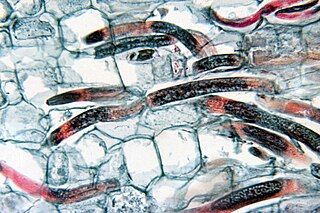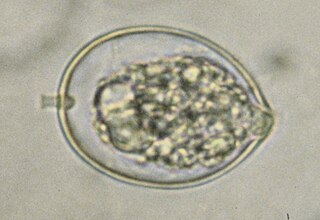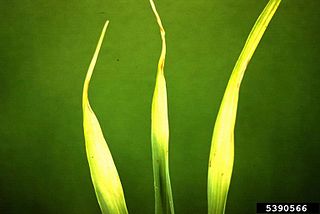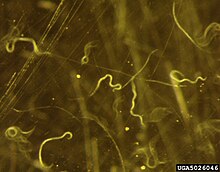
A leaf spot is a limited, discoloured, diseased area of a leaf that is caused by fungal, bacterial or viral plant diseases, or by injuries from nematodes, insects, environmental factors, toxicity or herbicides. These discoloured spots or lesions often have a centre of necrosis. Symptoms can overlap across causal agents, however differing signs and symptoms of certain pathogens can lead to the diagnosis of the type of leaf spot disease. Prolonged wet and humid conditions promote leaf spot disease and most pathogens are spread by wind, splashing rain or irrigation that carry the disease to other leaves.

Radopholus similis is a species of nematode known commonly as the burrowing nematode. It is a parasite of plants, and it is a pest of many agricultural crops. It is an especially important pest of bananas, and it can be found on coconut, avocado, coffee, sugarcane, other grasses, and ornamentals. It is a migratory endoparasite of roots, causing lesions that form cankers. Infected plants experience malnutrition.

Potato leafroll virus (PLRV) is a member of the genus Polerovirus and family Solemoviridae. The phloem limited positive sense RNA virus infects potatoes and other members of the family Solanaceae. PLRV was first described by Quanjer et al. in 1916. PLRV is transmitted by aphids, primarily the green peach aphid, Myzus persicae. PLRV is one of the most important potato viruses worldwide but particularly devastating in countries with limited resources and management. It can be responsible for individual plant yield losses of over 50%. One estimate suggests that PLRV is responsible for an annual global yield loss of 20 million tons. Symptoms include chlorosis, necrosis and leaf curling.

Pseudomonas cichorii is a Gram-negative soil bacterium that is pathogenic to plants. It has a wide host range, and can have an important economical impact on lettuce, celery and chrysanthemum crops. P. cichorii was first isolated on endives, from which it derives its name. It produces 6-aminopenicillanic acid. Based on 16S rRNA analysis, P. cichorii has been placed in the P. syringae group.

Phytophthora cactorum is a fungal-like plant pathogen belonging to the Oomycota phylum. It is the causal agent of root rot on rhododendron and many other species, as well as leather rot of strawberries.
Xanthomonas fragariae is a species of bacteria. It causes a leaf spot disease found in strawberries. The type strain is NCPPB1469 from Fragaria chiloensis var. ananassa.

Albugo is a genus of plant-parasitic oomycetes. Those are not true fungi (Eumycota), although many discussions of this organism still treat it as a fungus. The taxonomy of this genus is incomplete, but several species are plant pathogens. Albugo is one of three genera currently described in the family Albuginaceae, the taxonomy of many species is still in flux.

Glomerella cingulata is a fungal plant pathogen, being the name of the sexual stage (teleomorph) while the more commonly referred to asexual stage (anamorph) is called Colletotrichum gloeosporioides. For most of this article the pathogen will be referred to as C. gloeosporioides. This pathogen is a significant problem worldwide, causing anthracnose and fruit rotting diseases on hundreds of economically important hosts.

Aphelenchoides ritzemabosi is a plant pathogenic nematode. It was first scientifically described in 1890 in England. This nematode has a wide host range. Among the most important species affected are Chrysanthemums and strawberries. A. ritzemabosi is a migratory foliar feeding nematode. It can feed both ectoparasitically and endoparasitically, with the later causing the most significant damage. When adequate moisture is present, this nematode enters the leaves and feeds from inside the tissue. Typical damage is characterized by necrotic zones between the veins of the leaves. Its lifecycle is short; only ten days from egg to mature adult. A single female can lay as many as 3,500 eggs. This pest can be difficult to control. Host plant resistance, hot water treatments, and predatory mites are recommended.
Ditylenchus destructor is a plant pathogenic nematode commonly known as the potato rot nematode. Other common names include the iris nematode, the potato tuber eelworm and the potato tuber nematode. It is an endoparasitic, migratory nematode commonly found in areas such as the United States, Europe, central Asia and Southern Africa.

Ditylenchus dipsaci is a plant pathogenic nematode that primarily infects onion and garlic. It is commonly known as the stem nematode, the stem and bulb eelworm, or onion bloat. Symptoms of infection include stunted growth, discoloration of bulbs, and swollen stems. D. dipsaci is a migratory endoparasite that has a five-stage lifecycle and the ability to enter into a dormancy stage. D. dipsaci enters through stomata or plant wounds and creates galls or malformations in plant growth. This allows for the entrance of secondary pathogens such as fungi and bacteria. Management of disease is maintained through seed sanitation, heat treatment, crop rotation, and fumigation of fields. D. dipsaci is economically detrimental because infected crops are unmarketable.
Xiphinema diversicaudatum is an amphimictic ectoparasitic nematode species. This species has a characteristically long stylet capable of penetrating into a host's vascular tissue. They have a wide host range with some of the extensively studied ones being strawberry, hops and raspberry, due to their economic importance. The direct root damage caused through penetration near the root tip and formation of galls is a secondary concern when compared with the damage caused by vectoring the Arabis mosaic virus. The virus attaches to the interior cuticle lining and can be transferred from infected to uninfected root tissue as the nematode feeds and sheds. Management of this particular nematode relies on nematicides such as 1,3-Dichloropropene (Telone) at 40 gpa.or methyl bromide at 1000 lb/ac to control to 28 in deep.

Aphelenchoides besseyi is a plant pathogenic nematode. It is sometimes referred to as rice white tip, spring dwarf, strawberry bud, flying strawberry nematode or strawberry crimp disease nematode. This foliar nematode is found in Africa, North, Central, and South America, Asia, Eastern Europe, and Pacific islands.
Strawberry foliar nematode, or strawberry crimp nematode, is a disease caused by Aphelenchoides fragariae, a plant pathogenic nematode. It is common in strawberries and ornamental plants and can greatly affect plant yield and appearance, resulting in a loss of millions of dollars of revenue. Symptoms used to diagnose the disease are angular, water soaked lesions and necrotic blotches. Aphelenchoides fragariae is the nematode pathogen that causes the disease. Its biological cycle includes four life stages, three of which are juvenile. The nematode can undergo multiple life cycles in one growing season when favorable conditions are present. The crowns, runners, foliage, and new buds of the plant via stylet penetration or through the stomata can be infected. The best management practices for this disease are sanitation, prevention of induction of the pathogen to the environment, and planting clean seed or starter plants.
Aphelenchoides is a genus of mycetophagous nematodes. Some species are plant pathogenic foliar nematodes.

Xanthomonas campestris pv. vesicatoria is a bacterium that causes bacterial leaf spot (BLS) on peppers and tomatoes. It is a gram-negative and rod-shaped. It causes symptoms throughout the above-ground portion of the plant including leaf spots, fruit spots and stem cankers. Since this bacterium cannot live in soil for more than a few weeks and survives as inoculum on plant debris, removal of dead plant material and chemical applications to living plants are considered effective control mechanisms.

Blueberry shoestring virus (BBSSV) is a disease-causing virus that is commonly transmitted by the aphid vector, Illinoia pepperi. The blueberry shoestring virus disease is very prominent in highbush and lowbush blueberry plants in the northeastern and upper Midwest of the United States. Symptoms can vary significantly depending on the environment, but the most common disease symptoms are reddish streaking on young stems, reduced vigor and strap-shaped leaves. The blueberry shoestring virus disease can be managed by eliminating the aphid vector through the use of biological, chemical or cultural controls. In severe cases, the disease leads to an extensive loss of yield and marketable fruit.

Common spot of strawberry is one of the most common and widespread diseases afflicting the strawberry. Common spot of strawberry is caused by the fungus Mycosphaerella fragariae. Symptoms of this disease first appear as circular, dark purple spots on the leaf surface. Mycosphaerella fragariae is very host-specific and only infects strawberry.
Botryotinia polyblastis is a fungal plant pathogen that causes Narcissus Fire of daffodils, genus Narcissus.













